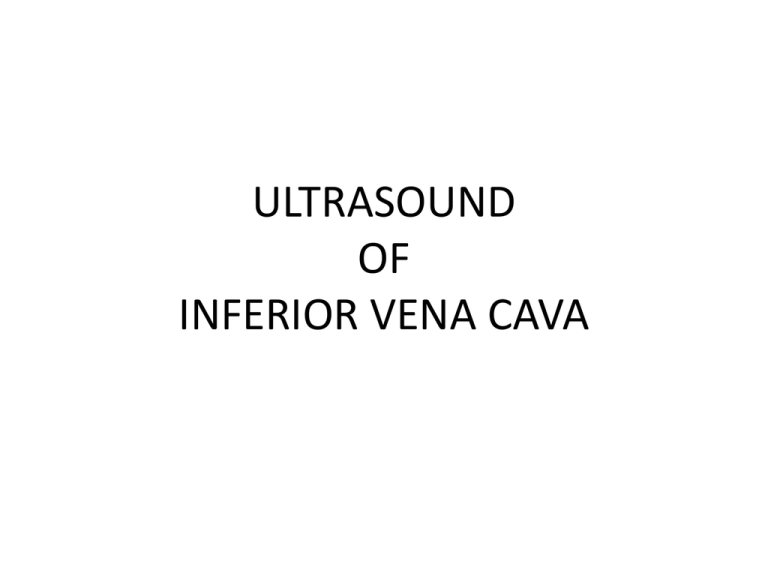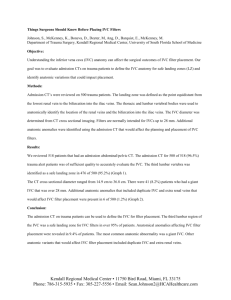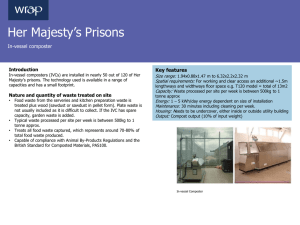IVC - UNM Hospitalist Group / FrontPage
advertisement

ULTRASOUND OF INFERIOR VENA CAVA OBJECTIVES Describe indications for using ultrasound at the bedside to image the inferior vena cava. Describe how to performing bedside ultrasound of the inferior vena cava. Use the findings on ultrasound to guide assessment of intravascular volume status. Generate group discussion regarding the potential value of learning this procedure for patient management CASE 46 M was admitted with alcoholic hepatitis and newly diagnosed cirrhosis with ascites. On exam he had flat JVD in supine position, tense abdominal distension, and moderate leg edema to the knees. He was started on a 28 day Trental protocol Hospital Course Day 1-9 - 3 paracenteses; - removal of 11 liters of ascitic fluid. Day 10 - JVD flat in supine position - Abdomen still distended but not tense - moderate leg edema - Na = 136, Cr = 1.0, BUN = 11 - furosemide started at 20 mg QD - spironolactone started at 50mg QD. CASE Day 12 - JVD flat in supine position - persistent leg edema - apparent increase in abdominal girth on exam - Na = 134, Cr = 0.7, BUN = 12 - furosemide increased to 40mg QD Day 19 - JVD flat in supine position - persistent leg edema - abdominal girth same to slightly decreased - Na = 136, Cr = 0.8, BUN = 12 - furosemide increased to 80mg QD - spironolactone increased to 200mg QD CASE Day 21 - JVD flat in supine position - leg edema the same - Abdominal girth the same - Na = 130, Cr = 0.9, BUN = 10 Day 24 - JVD flat in the supine position - leg edema the same - Abdominal girth the same to slightly increased - Na = 127, Cr = 0.7, BUN = 13, Urine Na < 10 Daily weights and Input/Output measures were collected sporadically and could not be assessed for any trends. CLASSIC HYPONATREMIA UNa UOsm > SOsm UNa > 40 UNa < 10 > 20 YES NO < 10 > 20 Volume Depletion Mineralcorticoid Deficiency SIADH OTHER Cirrhosis Nephrosis CHF CKD QUESTION What type of hyponatremia does this patient have and how should it be managed? A. Hypovolemic hyponatremia stop diuretics; begin normal saline infusion; liberalize po fluid intake; monitor Na over the course of the next several days; if Na does not improve or worsens, entertain hypervolemic hyponatremia as the cause A. Hypervolemic hyponatremia increase the diuretics and tighten the fluid restriction; monitor Na over the course of the next several days; if Na does not improve or worsens, entertain hypovolemic hyponatremia as the cause. A. Not sure consult nephrology for an opinion about the hyponatremia INDICATIONS IVC Ultrasound Spontaneously Breathing Volume Status / CVP Mechanical Ventilation Fluid Responsiveness INDICATIONS Assessing Intravascular Volume Status / CVP VOLUME DEPLETED STATES - Hyponatremia - Acute Kidney Injury (? Prerenal) - Diuretic therapy - Sepsis VOLUME OVERLOAD STATES -Hyponatremia - Heart Failure -Cirrhosis with ascites - Anasarca INDICATIONS Assessing Fluid Responsiveness in Shock - IVC diameter does not correlate with right atrial pressure in patients who are intubated with shock - Measuring the variation in IVC diameter in these situations can help determine whether the patient’s blood pressure will respond to fluids or whether inotropic support (i.e. dobutamine) will be needed Anatomy The inferior vena cava returns blood from the body to the right atrium Formed by the convergence of the illiac veins Retroperitoneal Right of the aorta Normal size <2.5 cm Varies w respiration Respiratory variation Expands w/ expiration Contracts w/ inspiration Due to changing intrathoracic pressures. Respiratory Variation Figure 2: Physiological respiratory variations in IVC diameter in a healthy volunteer breathing quietly.: From: http://www.pifo.uvsq.fr/hebergement/webrea/index.php?option=com_content&task=view&id=36&Itemid=93 IVC diameter decreases on each inspiration. http://www.criticalecho.com/content/tutorial-4-volume-status-and-preload-responsiveness-assessment Measuring the IVC Diameter Measure IVC 2cm distal to right atrium Inspiratory (Minimal) IVC Diameter Maximum (Expiratory) IVC Diameter M-Mode IVC Diameters CAVAL INDEX (CI) maximum (expiratory) diameter CI minimal (inspiratory) diameter = maximum (expiratory) diameter CAVAL INDEX (CI) 0% Volume Overload 100% Volume Depletion IVC v CVP Correlation Between IVC Diameter Plus CI and CVP IVC Max Diameter (cm) CI CVP (mmHg) < 1.5 100% (total collapse) 0-5 1.5-2.5 > 50% 6-10 1.5-2.5 < 50% 11-15 > 2.5 < 50% 16-20 > 2.5 0% (no collapse) >20 M-Mode Volume Depletion M-Mode Volume Overload IVC v CVP Correlation Between IVC Diameter Plus CI and CVP IVC Max Diameter (cm) CI CVP (mmHg) < 1.5 100% (total collapse) 0-5 1.5-2.5 > 50% 6-10 1.5-2.5 < 50% 11-15 > 2.5 < 50% 16-20 > 2.5 0% (no collapse) >20 PROCEDURE Positioning 1 Supine 2 Degree of head elevation has not been shown to make a significant difference in measurements PROCEDURE Probe Selection 1 Low frequency 2-5 MHz 2 Curvalinear probe PROCEDURE Approach #1 – Xiphoid View PROCEDURE Landmarks Aproach #1 – Xiphoid View 1 Most common approach 2 Place probe longitudinally just below the xiphoid process with the probe marker to the patient’s head 3 Look for IVC going into right atrium – may need to move probe 1-2cm to patient’s right and then tilt it slightly towards the heart IVC Longitudinal PROCEDURE Approach #2 – Anterior Mid-Axillary View PROCEDURE Landmarks Aproach #2 – Anterior Mid-Axillary View 1 Place probe longitudinally in right anterior mid-axillary line with marker towards the head 2 Look for IVC running longitudinally adjacent to liver crossing the diaphragm. 3 Track superiorly until it enters right atrium confirming that it is the IVC and not the aorta. IVC Anterior Mid-Axillary View PEARLS Bowel Gas 1 May impede visualization in the xiphoid view 2 Gentle graded pressure may help move bowel out of way 3 Don’t press too hard or will collapse IVC causing false measurements 4 Consider anterior mid-axillary view PEARLS Plethoric (dilated/sluggish) IVC 1 2 3 4 Volume overload Cardiac tamponade Mitral regurgitation Aortic stenosis PEARLS Mechanical Ventilation 1 Causes reversal of IVC changes with respiration 2 Maximum diameter with inspiration, minimum diameter with expiration PEARLS IVC v Aorta Aorta IVC Thick, echogenic walls Pulsatile High flow velocity Not compressable No respiratory variation Above vertebral bodies Thin walls Usually not pulsatile Low flow velocity Compressable Respiratory variation Right of vertebral bodies Aorta – Longitudinal View SonoSite 180 Plus SonoSite 180 Plus SonoSite 180 Plus Changing and Inserting the Transducer SonoSite 180 Plus Insert the transducer Twist lock counterclockwise SonoSite 180 Plus Fold lock down SonoSite 180 Plus Ready to power-up machine SonoSite 180 Plus Power Button SonoSite 180 Plus SonoSite 180 Plus SonoSite 180 Plus SonoSite 180 Plus Wrong Transducer is Connected Correct Transducer Menu -GYN -OB -Abdominal SonoSite 180 Plus 2D View (default) M-Mode SonoSite 180 Plus GAIN Changes the contrast on the screen SonoSite 180 Plus SonoSite 180 Plus CASE An IVC Ultrasound was performed at the bedside. Maximum IVC diameter during expiration = 1.10 cm. The Minimum IVC diameter during inspiration = 0 cm. Caval Index = 100% (total collapse) CASE Correlation Between IVC Diameter Plus CI and CVP IVC Max Diameter (cm) CI CVP (mmHg) < 1.5 100% (total collapse) 0-5 1.5-2.5 > 50% 6-10 1.5-2.5 < 50% 11-15 > 2.5 < 50% 16-20 > 2.5 0% (no collapse) >20 Interpretation: Mixed hyponatremia (intravascular volume depletion plus free water excess from cirrhosis) CASE Treatment: - one liter of normal saline IV to expand intravascular volume - reduced free water oral intake from 1500cc to 1000cc/d - Continued current diuretic dosing to remove free water Result: In 3 days, the patient’s Na progressively increased to 136 REFERENCES -De Lorenzo RA, Morris MJ, William JB, et al. Does a simple bedside sonographic measurement of the inferior vena cava correlate to central venous pressure? J. Emer. Med. 2011; 42(4); 429-436. -Kosiak W, Swieton D, Piskunowicz M. Sonographic inferior vena cava/aorta diameter index, a new approach to the body fluid status assessment in children and young adults in emergency ultrasound preliminary study. Acad. J. Emerg. Med. 2008;26:320-5 -Blehar DJ, Dickman E, Gaspari R. Identification of congestive heart failure via respiratory variation of inferior vena cava diameter. Am. J. Emerg. Med. 2009;27:71-5. -Chen L, Santucci KA, Kim Y. Use of ultrasound measurement of the inferior vena cava diameter as an objective tool in the assessment of children with clinical dehydration. Acad. Emerg. Med. 2007:14:841-5. -Feissel M, Michard F, Faller JP, et al. The respiratory variation in inferior vena cava diameter as a guide to fluid therapy. Intensive Care Med. 2004;30:1834-7. -Fields JM, Lee PA, Jenq KY, et al. The interrater reliability of inferior vena cava ultrasound by bedside clinician sonographers in emergency department patients. Acad. Emerg. Med. 2011;18:98-101. -Kircher BJ, Himelman RB, Schiller NB. Noninvasive estimation of right atrial pressure from the inspiratory collapse of the inferior vena cava. Am J. Cardiol. 1990;66:493-6. -Randazzo MR, Snoey ER, Levitt MA, et al. Accuracy of emergency physician assessment of left ventricular ejection fraction and central venous pressure using echocardiography. Acad. Emerg. Med.2003;10:973-7. -ACEP Policy Statement on Emergency Ultrasound Guidelines. Ann. Emerg. Med. 2009;53:550-70 -Nagdev AD, Merchant RC, Tirado-Gonzalez A, et al. Emergency department bedside ultrasonographic measurement of the caval index for noninvasive determination of low central venous pressure. Ann. Emerg. Med. 2010;55:290-5. DISCUSSION










